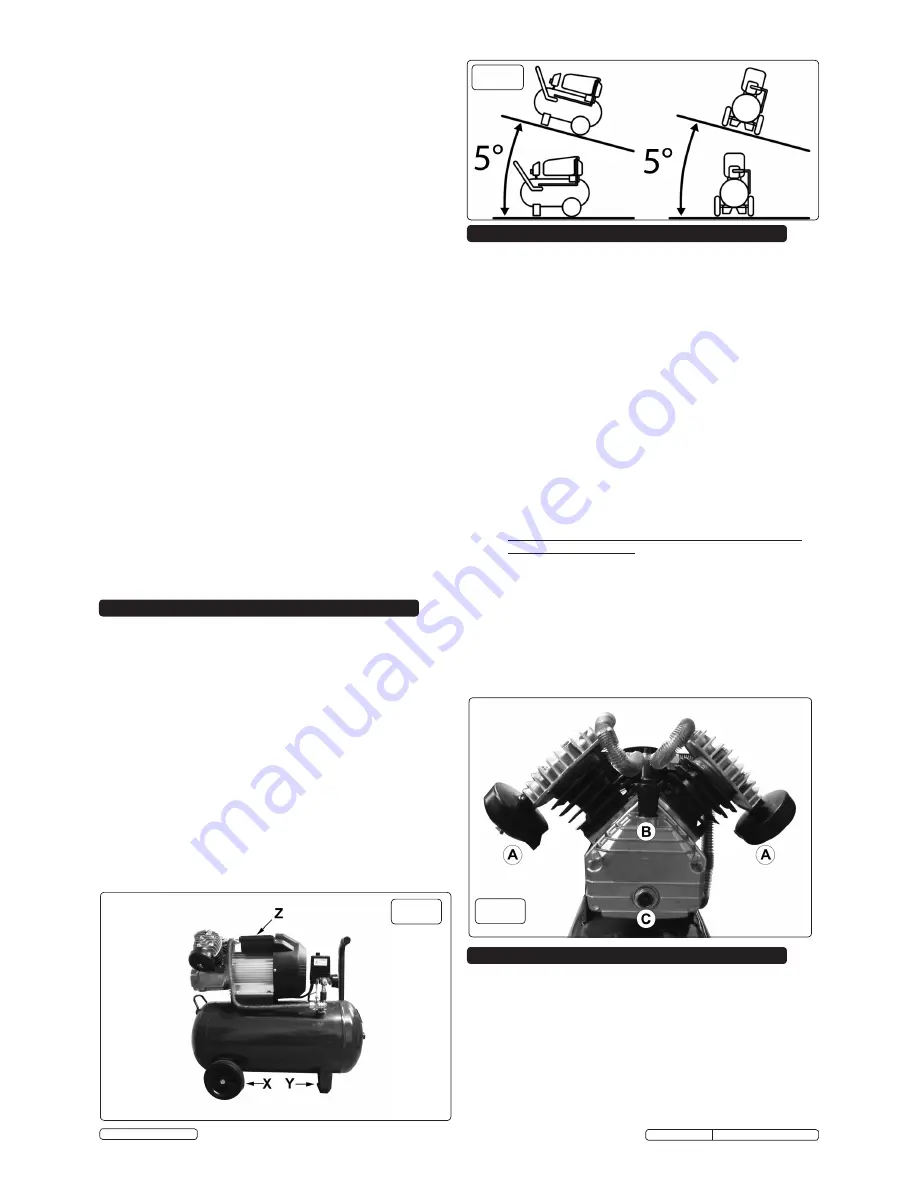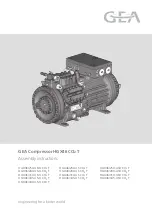
4. OPERATION
V-Twin pump with aluminium cylinders and cast iron liners for
reduced weight and improved resistance to wear. Suitable for general
purpose workshop applications. Pump directly coupled to heavy-duty
induction motor for reliable operation. Precision welded receiver tank
manufactured to meet Pressure Vessel Directive 2009/105/EC. Fitted
with fully automatic pressure cut-out switch, air regulator and
pressure gauges for tank and supply. Supplied with handle and
wheels for easy manoeuvrability. Fitted with ASTA/BS approved
non-rewirable plug.
3. PREPARATION
3.1.
Remove compressor from packaging and inspect for any
shortages or damage. If anything is found to be missing or
damaged contact your supplier.
3.2.
Save the packing material for future transportation of the
compressor. We recommend that you store the packing in a
safe location, at least for the period of the guarantee. Then, if
necessary, it will be easier to send the compressor to the
service centre.
3.3.
Confirm that the mains voltage corresponds with the voltage
shown on the compressor data plate.
3.4.
Assemble the wheels (fig.A.X) and rubber feet (fig.A.Y) to
the main frame using the nuts, bolts and washers supplied.
3.5.
The compressor should be operated on a flat surface, or one
that does not exceed 5° either transversely or longitudinally
(fig.1), and should be in a position that allows good air
circulation around the unit.
3.6.
The compressor is supplied without oil in it. The oil is in a
separate container. Remove the transit plug from the oil filler
aperture, pour oil into the aperture until it has reached the
correct level on the sight glass (fig.2C). Fit the oil filler/
breather supplied into the aperture.
DO NOT ATTEMPT TO RUN THE COMPRESSOR UNTIL
THIS HAS BEEN DONE.
3.7.
Ensure that the air vent in the oil filler/breather is free
from debris. If the air vent is blocked, pressure can build
up in the crankcase causing damage to the compressor
and possible personal injury.
(fig.2C)
3.8.
Screw the back half of a filter unit into the downward facing
port openings in each head as shown in fig.2.A. Place a filter
cover over each threaded rod protruding from the back half
of the filter and secure each with a wing nut. Refer also to
fig.4.
fig.2
WARNING! Ensure that you have read, understood and
apply Section 1 safety instructions.
4.1. IMPORTANT. The use of extension leads to connect this
compressor to the mains is not recommended as the
resulting voltage drop reduces motor, and therefore
pump, performance and could damage your compressor.
4.2. Take care when selecting tools for use with the
compressor. Air tool manufacturers normally express the
volume of air required to operate a tool in cubic feet per
minute (cfm).
fig.A
2. INTRODUCTION & SPECIFICATION
3
Use the compressor in a well ventilated area and ensure it
is placed on a firm surface.
3
Keep tools and other items away from the compressor when
it is in use, and keep area clean and clear of unnecessary
items.
3
Ensure the air hose is not tangled, twisted or pinched.
3
Keep children and unauthorised persons away from the
working area.
7
DO NOT
disassemble compressor for any reason. The unit
must be checked by qualified personnel only.
7
DO NOT
use the compressor outdoors, or in damp, or wet,
locations.
7
DO NOT
operate within the vicinity of flammable liquids,
gases or solids.
7
DO NOT
touch compressor cylinder, cylinder head or pipe
from head to tank as these may be hot.
7
DO NOT
use this product to perform a task for which it has
not been designed.
7
DO NOT
deface the certification plate attached to the
compressor tank.
7
DO NOT
cover the compressor or restrict air flow around the
unit whilst operating.
q
DANGER! DO NOT
direct the output jet of air towards
people or animals.
7
DO NOT
operate the compressor without an air filter.
7
DO NOT
allow anyone to operate the compressor unless
they have received full instructions.
WARNING!
The air tank is a pressure vessel and the
following safety measures apply:
7
DO NOT
tamper with the safety valve,
DO NOT
modify or
alter the tank in any way and
DO NOT
strap anything to the
tank.
7
DO NOT
subject the tank to impact, vibration or to heat and
DO NOT
allow contact with abrasives or corrosives.
3
Drain condensation from tank daily.
WARNING!
If an electrical fuse blows, ensure it is
replaced with an identical fuse type and rating.
3
When not in use, store the compressor carefully in a safe,
dry, childproof location.
MODEL No:
...................................................................
SAC10030VE
Motor Output: .................................................................................3hp
Voltage/Phase: ...................................................................230V - 1ph
Rated Supply: .................................................................................13A
Air Displacement cfm(ltr/min): .............................................. 12.6(357)
Maximum Free Air Delivery cfm(ltr/min): ................................ 8.8(249)
Receiver Capacity: ......................................................................100ltr
Max Pressure: .................................................................116psi / 8bar
Weight: .........................................................................................52kg
Dimensions (W x D x H): ......................................890 x 450 x 760mm
fig.1
Original Language Version
© Jack Sealey Limited
SAC10030VE Issue No: 2(I) - 17/04/14






















